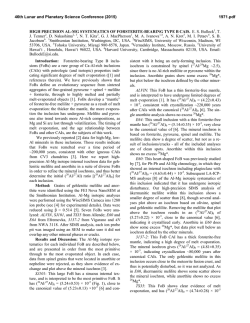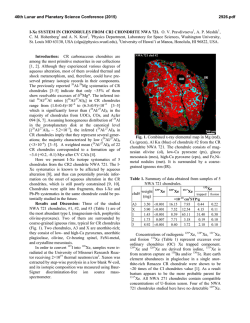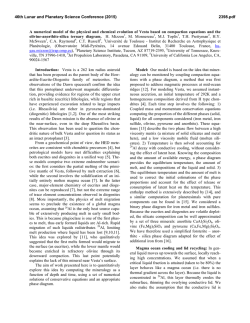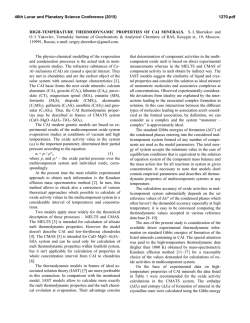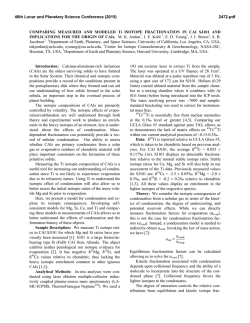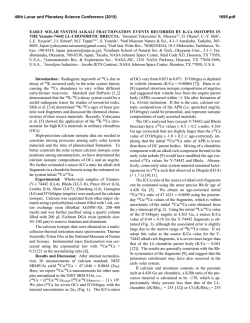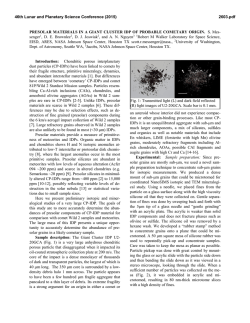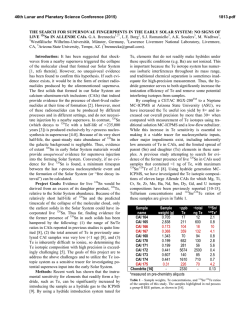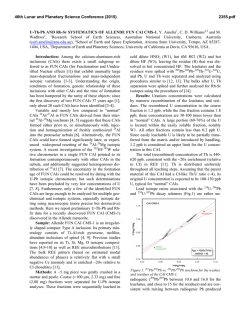
A Search for Synchronicity Between Aluminum-26 and Calcium-41
46th Lunar and Planetary Science Conference (2015) 1282.pdf A SEARCH FOR SYNCHRONICITY BETWEEN ALUMINUM-26 AND CALCIUM-41 IN THE EARLY SOLAR SYSTEM. M.-C. Liu, Dept. of Earth, Planetary and Space Sciences, UCLA ([email protected]). Introduction: The origins of short-lived radionuclides (t1/2 ≤ 100 Myr) have important implications for the chronology and birth environment of the early Solar System. Of all shortest-lived (t1/2 < 10 Myr) radioactivities, 26Al (t1/2 = 0.7 Myr) and 41Ca (t1/2 = 0.1 Myr) are of special interest as they were found to have been correlated with one another in terms of the absence or presence in meteoritic refractory inclusions, such as Ca-Al-rich inclusions (CAIs) and hibonite (CaAl12O19) grains [1]. This correlation has been often used as an argument for co-injection of the two radioisotopes from a common stellar source after the solar nebula and a small fraction of high-temperature solids had already formed (“late injection”) [2]. It should however be noted that 26Al correlating with 41Ca has remained fairly qualitative (i.e., they either co-existed or were both absent in refractory inclusions). Although the study of [3] revealed a hint that there could have been concordant decay between 26Al and 41Ca, the small number (~3) of samples in which this observation was made and large analytical uncertainties associated with the initial 41Ca/40Ca values (up to 40%, 2σ) precluded a definitive answer. In this study, we attempt to reinvestigate the correlation between 26Al and 41Ca more quantitatively by analyzing the potassium isotopic compositions of a suite of CAIs characterized by 26Al/27Al ratios ranging from 5.2×10−5 to 3×10−5. The expected 41Ca/40Ca values from this suite of samples should fall between 4.2×10−9 and essentially 0. The result will provide a constraint on the astrophysical origin(s) of 26Al and 41 Ca and the timing of injection. Here we report some preliminary results on the 26Al/27Al and 41Ca/40Ca values in a Leoville CAI. Experimental: The sample studied here, Leoville 2-A, is a compact Type A CAI primarily composed of melilite and spinel. The magnesium and potassium isotopic compositions of this CAI were measured with the UCLA ims-1270 ion microprobe. The analytical setting for high precision Mg isotopic measurements was similar to that described in [4]. A 20−25 nA 16O− primary beam (ϕ ~ 30µm) was used to generate sufficient Mg signals (24Mg+ ≥ 107 cps) for accurate current measurements by Faraday cups. The mass resolution (M/ΔM) was set at ~ 4200 to completely separate molecular and major doubly charged ion interferences (48Ca++ and 48Ti++). The instrumental mass fractionation was characterized by using a suite of terrestrial standards (a synthetic fassaite glass, San Carlos olivine, Burma spinel and Madagascar hibonite) and cor- rected. The deviation of measured Mg isotopic ratio from the reference value is expressed with the modified delta notation: δ25,26Mg = 1000 × ln[(25,26Mg/24Mg)m/(25,26Mg/24Mg)ref]. By assuming an exponential mass fractionation law and an exponent of 0.514 [5], the radiogenic excesses of 26Mg were then calculated with the relationship: Δ26Mg* = δ26Mg – δ25Mg/0.514. The true 27Al+/24Mg+ ratio of each spot was derived by applying the relatively sensitivity factor determined on a synthetic glass of fassaite composition. The potassium isotope analysis of the CAI was performed by following the protocol established in [3] The sample was sputtered by a 10 nA 16O− primary beam, and the secondary ions were collected by the axial electron multiplier in a peak-jumping mode, with the mass sequence of 38.7, 39K+, 41K+, 40CaH+, (40Ca43Ca)++, (40Ca27Al16O)++, 42Ca+ and 43Ca+. For sufficient separation between 40CaH+ and 41K+, mass resolution of ~7000 was set. Prior to each analysis, ~15−25 minute presputtering was applied to the sample surface to minimize contaminations. All isotopic ratios were calculated after summing up all the counts to avoid ratio bias [6]. Results: The result of Al-Mg isotopic measurements is shown in Fig 1. All the points were measured in melilite, except one (27Al/24Mg ~ 3) being a mixture of spinel and melilite. A free fit through all the data yields an 26Al/27Al ratio of (3.58±0.15)×10−5 (2σ), with an intercept (Δ26Mg*0) = (0.74±0.11)‰ (2σ) and a reduced χ2 = 30.3. Such a low 26Al/27Al ratio with a large scatter along the isochron is likely to have resulted from partial isotopic resetting of the CAI, as some of the spots are consistent with having incorporated canonical 26Al/27Al = 5.2×10−5 (reference line). The 41Ca-41K isotope result is shown in Fig 2. Only in melilite crystals could reasonably high 40Ca/39K ratios be obtained, albeit all below 106. However, all the spots are devoid of radiogenic excesses of 41K that could be derived from the decay of 41Ca. The slope of a least-squares regression line indicates a 41Ca/40Ca ratio of (−0.79±2.09)×10−9 (2σ, χ2 = 3.3) in the CAI. The intercept (41K/39K) being 0.0724±0.0003 is consistent with the terrestrial value (= 0.072). Discussion and Conclusion: According to the Mg isotope result, it is clear that the Leoville 2-A CAI had undergone post-formation isotopic disturbance. However, it is unlikely that isotopic closure was comprised when 26Al/27Al was at (3.58±0.15)×10−5 because of the very large scatter of points about the isochron (reduced 46th Lunar and Planetary Science Conference (2015) References: [1] Sahijpal S. et al. (1998) Nature, 391, 559−562 [2] Sahijpal S. and Goswami J. N. (1998) ApJL, 509 L137−L140 [3] Liu M.-C. et al. (2012) ApJ, 761, 137(7pp) [4] Liu M.-C. et al. (2009) GCA, 73, 5051−5079 [5] Davis A. M. et al. (2005) LPS XXXVI, #2334 (abstract) [6] Ogliore R. C., Huss G. R. and Nagashima K. (2011) Nucl. Inst. Meth. Phys. Rev. B, 269, 1910−1918 [7] Ito and Ganguly (2004) MAPS, 39, 1911−1919 20 18 5 16 27 14 26 Al / Al 1 .2× =5 0 26 Mg* 12 10 8 6 4 2 0 0 27 Al 26 Al/ = 0.1 58 ± (3. 10 10 5)× 5 20 27 30 24 40 50 Al/ Mg Fig 1. The Al-Mg plot for the Leoville 2-A CAI. The solid line is the best fit through all the data points, whereas the dashed line is the reference line representing 26Al/27Al = 5.2×10−5. All errors are 2σ. 0.076 0.075 0.074 40 C a 41 C a/ = 4x 10 9 0.073 39 K/ K 0.072 41 Ca/ 40Ca = ( 0.7 9±2.09)x10 9 0.071 41 χ2 = 30.3). As there is no clear correlation between the spots that have been reset and their locations within the CAI, it is not possible to assess how many postformation thermal events this CAI experienced (i.e., no well-defined isochrons can be designated to specific areas), thus the timing of last isotopic closure. However, one could still infer that this CAI must have formed early. This is indicated by the fact that 9 out of 19 spots are plotted along the 26Al/27Al = 5.2×10−5 reference line. The best fit through these 9 spots results in 26 Al/27Al = (4.95±0.21)×10−5 (2σ) and Δ26Mg*0 = (0.33±0.13)‰ (χ2 = 1.3). It is therefore reasonable to deduce that this CAI could have formed with 26Al/27Al ~5×10−5 and the large Δ26Mg* scatter seen in the data resulted from isotopic disturbance that only reset part of the inclusion. Under the assumption that Leoville 2-A formed while 26Al/27Al ~5×10−5 and that 41Ca and 26Al were derived from the same source, this CAI should have also incorporated 41Ca at the level of 41Ca/40Ca ~ (34)×10−9. However, there are no resolvable excesses of 41 K in the CAI that can be attributed to the decay of 41 Ca. This can also be understood in the context of isotopic resetting. The K self-diffusivity in melilite is marginally slower than that of Mg (6.74×10−19 and 9.43×10−19 m2 s−1 at 1200 °C, respectively, [7]), so that the thermal event(s) that largely disturbed the Mg isotopes of the CAI could have easily erased 41K excesses. If the time at which the last perturbation took place was > 0.3 Myr (consistent with the time difference calculated between 26Al/27Al = 5×10−5 and 3.58×10−5) after CAI formation, 41Ca/40Ca would be too low (< 5×10−10) and 41K excesses would be essentially undetectable in this CAI (all spots have 40Ca/39K < 106). Isotopic analyses of the Leoville 2-A CAI have shown that the Mg and K isotopes have been largely reset in part of the inclusion and therefore does not provide constraints on the concordant decay between 26 Al and 41Ca. Having said that, it still falls within the expectation of 41Ca/40Ca being 0 in a CAI with 26 Al/27Al ~3×10−5. More CAIs that have well characterized 26Al isochrons will be examined for the K isotopes in future studies. 1282.pdf 0.07 0.069 0.068 0.067 0.066 0 2 4 40 Ca/39K 6 8 10 5 x 10 Fig 2. The 41Ca-41K plot for the Leoville 2-A CAI. The solid line is the best fit through all the data points, whereas the dotted line stands for 41Ca/40Ca = 4×10−9. The dashed line indicates the terrestrial 41K/39K value of 0.072. All errors are 2σ.
© Copyright 2024
